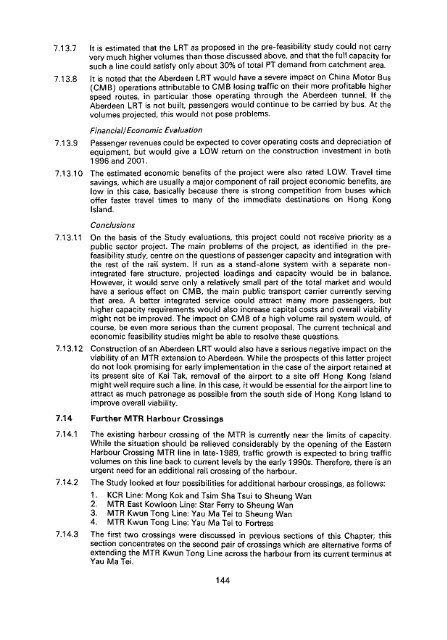Untitled - HKU Libraries - The University of Hong Kong
Untitled - HKU Libraries - The University of Hong Kong
Untitled - HKU Libraries - The University of Hong Kong
- No tags were found...
Create successful ePaper yourself
Turn your PDF publications into a flip-book with our unique Google optimized e-Paper software.
7.13.7 It is estimated that the LRT as proposed in the pre-feasibility study could not carryvery much higher volumes than those discussed above, and that the full capacity forsuch a line could satisfy only about 30% <strong>of</strong> total PT demand from catchment area.7.13.8 It is noted that the Aberdeen LRT would have a severe impact on China Motor Bus(CMB) operations attributable to CMB losing traffic on their more pr<strong>of</strong>itable higherspeed routes, in particular those operating through the Aberdeen tunnel. If theAberdeen LRT is not built passengers would continue to be carried by bus. At thevolumes projected, this would not pose problems.Financial/Economic Evaluation7.13.9 Passenger revenues could be expected to cover operating costs and depreciation <strong>of</strong>equipment but would give a LOW return on the construction investment in both1996 and 2001.7.13.10 <strong>The</strong> estimated economic benefits <strong>of</strong> the project were also rated LOW. Travel timesavings, which are usually a major component <strong>of</strong> rail project economic benefits, arelow in this case, basically because there is strong competition from buses which<strong>of</strong>fer faster travel times to many <strong>of</strong> the immediate destinations on <strong>Hong</strong> <strong>Kong</strong>Island.Conclusions7.13.11 On the basis <strong>of</strong> the Study evaluations, this project could not receive priority as apublic sector project. <strong>The</strong> main problems <strong>of</strong> the project, as identified in the prefeasibilitystudy, centre on the questions <strong>of</strong> passenger capacity and integration withthe rest <strong>of</strong> the rail system. If run as a stand-alone system with a separate nonintegratedfare structure, projected loadings and capacity would be in balance.However, it would serve only a relatively small part <strong>of</strong> the total market and wouldhave a serious effect on CMB, the main public transport carrier currently servingthat area. A better integrated service could attract many more passengers, buthigher capacity requirements would also increase capital costs and overall viabilitymight not be improved. <strong>The</strong> impact on CMB <strong>of</strong> a high volume rail system would, <strong>of</strong>course, be even more serious than the current proposal. <strong>The</strong> current technical andeconomic feasibility studies might be able to resolve these questions.7.13.12 Construction <strong>of</strong> an Aberdeen LRT would also have a serious negative impact on theviability <strong>of</strong> an MTR extension to Aberdeen. While the prospects <strong>of</strong> this latter projectdo not look promising for early implementation in the case <strong>of</strong> the airport retained atits present site <strong>of</strong> Kai Tak, removal <strong>of</strong> the airport to a site <strong>of</strong>f <strong>Hong</strong> <strong>Kong</strong> Islandmight well require such a line. In this case, it would be essential for the airport line toattract as much patronage as possible from the south side <strong>of</strong> <strong>Hong</strong> <strong>Kong</strong> Island toimprove overall viability.7.14 Further MTR Harbour Crossings7.14.1 <strong>The</strong> existing harbour crossing <strong>of</strong> the MTR is currently near the limits <strong>of</strong> capacity.While the situation should be relieved considerably by the opening <strong>of</strong> the EasternHarbour Crossing MTR line in late-1989, traffic growth is expected to bring trafficvolumes on this line back to current levels by the early 1990s. <strong>The</strong>refore, there is anurgent need for an additional rail crossing <strong>of</strong> the harbour.7.14.2 <strong>The</strong> Study looked at four possibilities for additional harbour crossings, as follows:1. KCR Line: Mong Kok and Tsim Sha Tsui to Sheung Wan2. MTR East Kowloon Line: Star Ferry to Sheung Wan3. MTR Kwun Tong Line: Yau Ma Tei to Sheung Wan4. MTR Kwun Tong Line: Yau Ma Tei to Fortress7.14.3 <strong>The</strong> first two crossings were discussed in previous sections <strong>of</strong> this Chapter; thissection concentrates on the second pair <strong>of</strong> crossings which are alternative forms <strong>of</strong>extending the MTR Kwun Tong Line across the harbour from its current terminus atYau Ma Tei.144
















